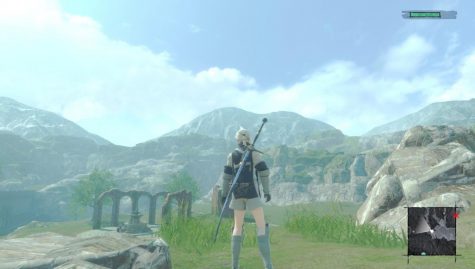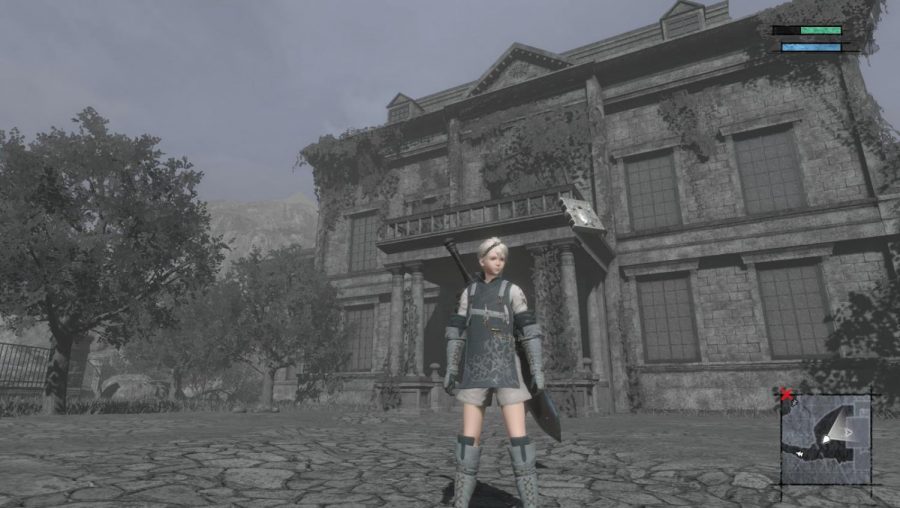The Revival of a 11 Year Old Franchise: ‘NieR Replicant’ and a ‘NieR:Automata’ Reboot
‘NieR Replicant’ highlights a new surge in the NieR franchise, changing a failed game in order to achieve new heights, and allowing fans to experience what developer Yoko Taro imagined for his magnum opus.
The main character of ‘NieR Replicant’ stands in front of a different setting, perfectly setting up the darker atmosphere of the story.
If you have ever been the slightest bit interested in open-world story games, you have most likely heard of NieR:Automata, an extremely popular game published in 2017 by Square Enix. NieR:Automata is likable for many reasons: it has fluid combat with fantastic animations and enemies, a well-crafted story that completely immerses you into its atmosphere, and an open-world setting that allows players to explore beautiful scenery as they please.
The game is highly rated and for good reason, as it provides a whole new experience for players new to the NieR franchise, although many people who have played NieR:Automata have never even touched the original NieR game.
The original version of NieR was, for all intents and purposes, a marketing failure, with poor sales to the disappointment of its studio, Cavia Games. The game’s themes of tragedy, despair and desperation can be seen as a parallel to Cavia Games’ trajectory of growth in terms of sales, the last stand of a game studio.
When NieR: Automata was in development, it was not expected to become a commercial success. But, to the surprise of NieR’s creator, Yoko Taro, the game flew off the shelves with many gamers vying for a chance to spend hours playing it. Taro said in a statement from Square Enix that “Automata selling was a fluke, and all my other stuff has hardly sold anything worthy of note.”
For players who want a taste of the original, Taro and his team have been long working on their newest project, NieR Replicant ver.1.22.474487139, a remaster of the original NieR from 2010. The remaster gives the game a whole new glossy cover, tuning up some of the older parts of the NieR series and adding a more modern feel to the game. This is especially shown in the visuals, which have been vastly improved.
NieR Replicant takes place thousands of years before NieR:Automata which provides a completely different outlook and atmosphere. NieR:Automata has a cyberpunk setting, with the world overrun by technology, while NieR Replicant is set in a more medieval setting. Within NieR Replicant’s story, the player will learn that people are suffering from a global disaster that brings civilization back to pre-electricity days, with candles rather than lightbulbs used for lighting.
Throughout the game, what remains constantly fantastic is the storyline. You play as a young boy attempting to save his sister, Yonah, from a terrible disease that has destroyed the world. Accompanying you are three critical characters; Kainé, a half-monster possessed woman, Grimoire Weiss, a living book as a character that allows the main character to access spells, and Emil, a young boy with a secret power that is unknown to the group.
The characters in NieR are a major part of why the story is so intriguing for a gamer. Unlike other games where you play as a character destined for greatness or one of the center pieces of the world, NieR Replicant’s main character is important on a much smaller scale. His only goal is to save his sister, not the world. With this prompt, the characters do not necessarily have to be heroes in order to accomplish their goals throughout the game. Many of the characters fall into a morally gray territory.
Even with the darker story and characters, the characters themselves are always a joy to be around. They all provide a different perspective and element to your party of misfits and provide a foil for the darkness within the game.
Besides the characters and story, what really makes the remake different from its original is the new modeling, sound track, improved fighting, fixed up backgrounds and overall improvements to the game.
The models have gotten the love they deserve, looking more human and smooth compared to the limited 2010 graphics. The animations are fluid and realistic, giving the game the visual flavor seen within Nier: Automata. The bosses themselves are extremely creative and fit the monstrous tone presented by the themes and settings of the game. The backgrounds are also less stiff and plain, adding in more landmarks, color, and feel, compared to the original game. Now that the studio can work with better technology, Nier Replicant became the visionary work that Taro wished to create.

Combat is also extremely fluid, taking lots of tricks from Nier:Automata. You can switch between using spells, running around to avoid attacks, and using your weapons to defeat enemies. Attacking animations and spells are all very visually appealing for the player and can easily draw someone into the combat aspect of the game.
One of the more controversial parts of the game is its take on endings. To complete the game and feel the impact of its entire story, you will have to replay it more than once in order to feel the full experience. Completing the game once will leave you with only half of the story, and replaying the entire game in order to see the other half can become a little tedious. However, I personally believe that the story is good enough to go through some of the boring parts over again, simply to complete the total experience that the game tries to convey.
In addition, the creators added new material into the story that were not in the original NieR game, such as new quests. These new additions shed more light into the story and its lore, adding in a bit more brightness to the bleak, exhausting original story of NieR. This, again, resembles NieR Replicant’s development. From what once was a last attempt to push a failing studio into any amount of relevancy to becoming the prequel of an award winning game, NieR Replicant was able to get a second chance at impacting a larger group of gamers. These bright additions are synonymous with the new hope and happiness of the creators rather than the depressing times of the original game’s creation.
In all, the game feels much more like a beloved passion project rather than a game meant to sell extremely well on the market, adding a lot of charm into the title and its series. It was never meant to be a critical success, as said by Yoko Taro in the same statement with Square Enix. “They [Square Enix] always give off this palpable aura of enthusiasm as if to say, ‘Look! NieR:Automata (the previous thing I made) did well, so NieR Replicant will also sell now.’ I would like to take this opportunity to tell Square Enix to take a good hard look at reality. Only the names are similar and the content of the two games is completely different, so it’s not really going to sell all that well now, is it lads?”
I think this is extremely inspiring for the industry as a whole. If NieR Replicant finds similar success to Nier:Automata, it will truly show that with the right backing, a passion project does not need a full corporate influence over game creators.
In all, NieR Replicant is an outstanding remaster of the original cult classic and will bring a whole new era of NieR fans more story to experience and to connect. For fans of the series, it provides a lot of content and an interesting story. For newer players, it gives a perfectly dark story that deviates from the normal ‘hero versus villain’ cliché that can become very repetitive after a few games.
In all, NieR Replicant is an outstanding remaster of the original cult classic and will bring a whole new era of NieR fans more story to experience and to connect.
Sophie Livingstone is an Editor-in-Chief for ‘The Science Survey.’ She enjoys both journalistic and creative writing and the influence that one can...











